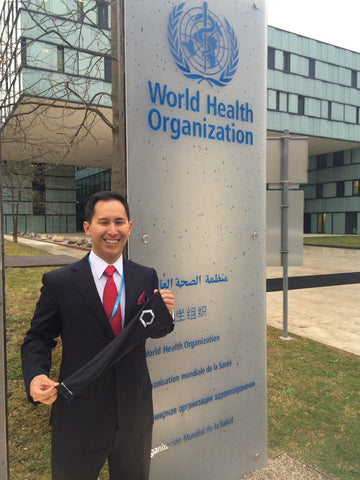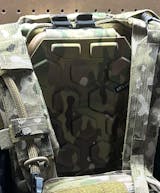When Washing Your Hands Is Not Enough: Using Cooling Vests to Reduce Heat Stress in Medical Workers, Health Care Providers, and First Responders Wearing PPE for Coronavirus/COVID-19

Coronavirus/COVID-19 is highly contagious and requires Personal Protective Equipment (PPE) be worn by healthcare providers and first responders to prevent further transmission and infection. However, PPE traps body heat and greatly increases fatigue and risk in users, reducing time available to treat patients. This problem is compounded with the lack of qualified medical professionals, especially in an epidemic or pandemic. For a detailed review of the different makes and models of cooling vests on the market today, click here.
Maximizing the endurance capacity of the limited number of qualified medical professionals to operate safely in contaminated environments provides more overall capacity to successfully manage the response.

PPE is a complicated beast. There are extensive standards, policies, and regulations on how it is worn correctly in various environments (to see just how extensive: OSHA’s PPE standards (29 CFR 1910 Subpart I). These standards are in place for good reason: used inappropriately, PPE provides a dangerously deceptive safety blanket. In contingency situations where the workload is heavier, other important safety factors, such as prevention of heat stress, come into consideration for overall risk management.
I saw the adverse effects of PPE up close and personal as an infantry soldier in the 101st Airborne Division during the ground invasion of Iraq in 2003. During the buildup in Kuwait, and our subsequent push north, we lived in our JSLIST NBC protective suits for weeks. Everything was harder. We did everything we could to keep cool, but shade and water were sparse and rest was often not an option. There were many tense hours where the SCUD missiles landed a little too close and we were under our gas masks waiting for the “all clear” (and wondering how legit that all clear was…). If I never see another NBC suit again, it will be too soon.
Available research and field observations indicate without a doubt that wearing PPE increases susceptibility to heat injuries and decreases human performance capacity. Universal guidelines for prevention include increased hydration. Many guidelines for prevention also include the use of some type of cooling vest under the PPE (woulda been nice back in Iraq..). Two recent studies from the National Institute for Occupational Safety and Health (NIOSH) found that cooling vests under PPE reduced signs of heat stress in both quantitative measurements, like heart rate and body temperature, and qualitative measurements, such as rate of perceived exertion and breathing comfort [citation].
Various forms of cooling vests have advantages and drawbacks, depending on their use context.
Phase Change Material (PCM) Vests encapsulate various substances that are frozen and then worn in the vest to absorb heat from the body as they melt (phase change) from solid to liquid form. More detail on the science can be found here.
Advantages:
- Readily available commodity
- Easy to wear in many sizes and form factors
Drawbacks:
- Relatively expensive compared to other options
- Single purpose piece of equipment
- Require freezing
- Undrinkable/unconsumable (static weight)
- Low Specific Heat (approximately 230 joules per gram)
- Short duration (approximately 30 minutes)
Recommendations and Considerations for Use:
- Work well under multiple heavy layers, such as mascot costumes
- Have multiple vests or inserts ready to change out when necessary
Evaporative Cooling Vests use a slightly different approach, allowing water soaked into a vest to absorb heat as it evaporates. These vests can also take advantage of convective cooling as even a slight breeze can amplify the cooling effect of the evaporation.
Advantages:
- Inexpensive relative to PCM vests
- Able to ‘recharge’ quickly and easily from a water source
- Can take advantage of convective (wind) cooling as well as limited conductive cooling
Drawbacks:
- Cannot be worn under PPE since airflow is required and must be worn outside all clothing
- Must be wet in order to work; all other garments will get wet
- Ineffective in humid environments
Recommendations and Considerations for Use:
- Great for manual labor tasks outdoors in arid climates, such as landscaping and construction
- Must have a water source nearby to recharge the vest, with recharge frequency depending on the Heat Index and workload.
Drinkable Cooling Vests take advantage of the science behind PCM (conductive cooling) and Evaporative Cooling Vests (Evaporative, Convective cooling) while also meeting hydration needs to further mitigate heat stress. Most powerful with greatest duration.
Advantages:
- Mitigates two of the main causes of heat stress (elevated core temperature and dehydration) in one piece of kit using drinking water already carried by end-users
- Can be used with or without a hydration tube, depending on contamination level and local standard operating procedures
- Can be used for cooling + hydration, or hydration only if freezing infrastructure is unavailable
- Adaptable to be worn under PPE and over other layers to tailor user comfort
- Highest Specific Heat (Energy Storage Density) of water at approximately 330 joules per gram
- Long lasting/duration: approximately 1-2 hours
- Dynamic weight (gets lighter as mission progresses because water (coolant) is consumed)
Drawbacks:
- Require freezing
- Costs are similar to PCM vests
Recommendations and Considerations for Use:
- Can be used in nearly any environment with limitless combinations of PPE
- Ensure hydration tube mouthpiece is protected from contaminants with a cover.
Examples:
- IceVest HiVis, IceVest Black, IcePlate EXO®
| Phase Change Material Vests | Evaporative Cooling Vests | Drinkable Cooling Vests | |
| Easily recharged | No | Yes: With water | No |
| Relative Cost | Most Expensive | Least Expensive | Most Expensive |
| Relative Efficiency | Moderate Efficiency | Conditions Dependent | Highest Efficiency |
| Best Environment | Any Environment | Arid Environment | Any Environment |
| Worn under PPE | Yes | No | Yes |
| Duration | ~30 min | Conditions Dependent | 1-2 hours |
| Multi-Use | No | No | Yes: Hydration |
| Relative Weight | Heaviest | Lightest | Dynamic |
We at Qore Performance® have enormous respect for the medical professionals and first responders that live in PPE, who daily demonstrate an incredible level of selflessness for their own personal comfort to provide for the health and safety of all of us. Qore Performance® is dedicated to our mission of supporting those who serve us by eliminating the environment as a constraint for human activity and performance. #StayFrosty out there, and for all of our sakes, wash your hands.









Leave a comment